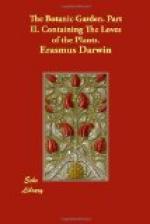With
vain desires the pensive ALCEA burns,
70 And, like sad ELOISA, loves and mourns.
The
freckled IRIS owns a fiercer flame,
And
three unjealous husbands wed the dame.
CUPRESSUS
dark disdains his dusky bride,
One
dome contains them, but two beds divide.
75 The proud OSYRIS flies his angry fair,
Two
houses hold the fashionable pair.
[Curcuma. l. 65. Turmeric. One male and one female inhabit this flower; but there are besides four imperfect males, or filaments without anthers upon them, called by Linneus eunuchs. The flax of our country has ten filaments, and but five of them are terminated with anthers; the Portugal flax has ten perfect males, or stamens; the Verbena of our country has four males; that of Sweden has but two; the genus Albuca, the Bignonia Catalpa, Gratiola, and hemlock-leaved Geranium have only half their filaments crowned with anthers. In like manner the florets, which form the rays of the flowers of the order frustraneous polygamy of the class syngenesia, or confederate males, as the sun-flower, are furnished with a style only, and no stigma: and are thence barren. There is also a style without a stigma in the whole order dioecia gynandria; the male flowers of which are thence barren. The Opulus is another plant, which contains some unprolific flowers. In like manner some tribes of insects have males, females, and neuters among them: as bees, wasps, ants.
There is a curious circumstance belonging to the class of insects which have two wings, or diptera, analogous to the rudiments of stamens above described; viz. two little knobs are found placed each on a stalk or peduncle, generally under a little arched scale; which appear to be rudiments of hinder wings; and are called by Linneus, halteres, or poisers, a term of his introduction. A.T. Bladh. Amaen. Acad. V. 7. Other animals have marks of having in a long process of time undergone changes in some parts of their bodies, which may have been effected to accommodate them to new ways of procuring their food. The existence of teats on the breasts of male animals, and which are generally replete with a thin kind of milk at their nativity, is a wonderful instance of this kind. Perhaps all the productions of nature are in their progress to greater perfection? an idea countenanced by the modern discoveries and deductions concerning the progressive formation of the solid parts of the terraqueous globe, and consonant to the dignity of the Creator of all things.]
[Alcea, l. 69. Flore pleno. Double hollyhock. The double flowers, so much admired by the florists, are termed by the botanist vegetable monsters; in some of these the petals are multiplied three or four times, but without excluding the stamens, hence they produce some seeds, as Campanula and Stramoneum; but in others the petals become so numerous as totally to exclude the stamens, or males; as Caltha, Peonia, and Alcea; these produce no seeds, and are termed eunuchs. Philos. Botan. No. 150.




